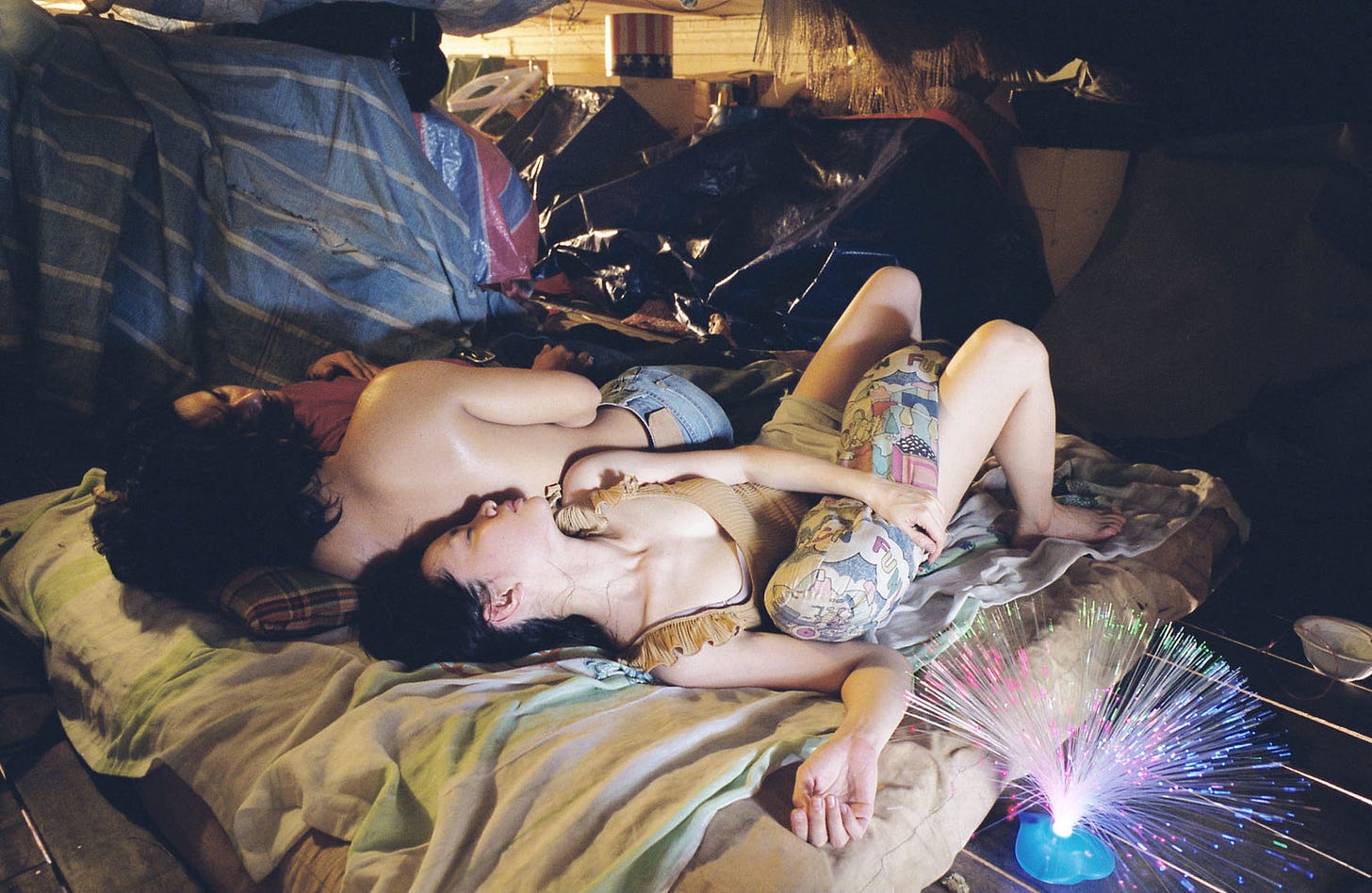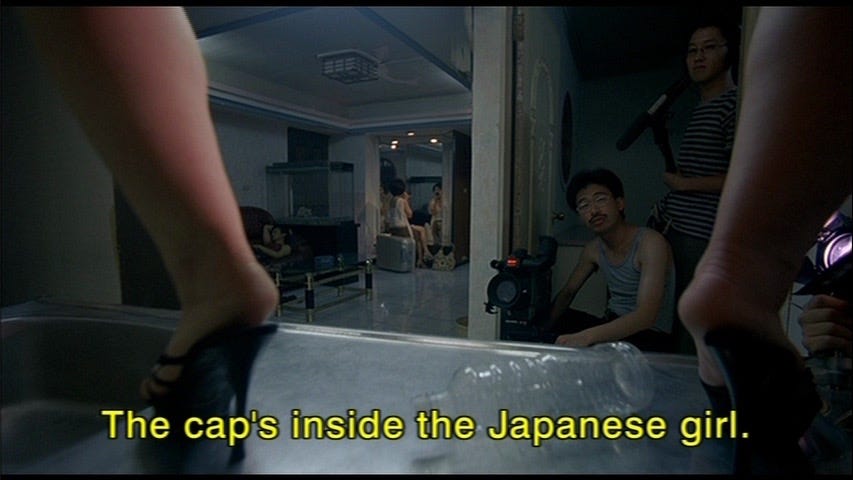Lee Kang-Sheng’s Ass
On Tsai Ming-Liang and Tiqqun. What gender is gender? Is there a theory of the Yung Boy's Ass?
And finally, the Young-Girl has declared war on war.—Tiqqun
Every body is a civil war. Callas sang the war.—Wayne Kostenbaum
In Tiqqun’s now infamous and somewhat unfashionable Preliminary Materials for a Theory of the Young-Girl, first published in 1999, a state of total war is declared. According to the anonymous authors, all affects and pathologies are an aggressive interplay which, we are told, ‘can no longer merely be called economic, social, or humanitarian’. Tiqqun’s book, much commented on by Ariana Reines and Nina Power among others, wants to make the battlefront of this war distinct, and it does so by introducing a kind of trash-meme, an iterative insider-concept meant to be provocative and banal, a memorable rhetorical implant in the polemological maze. That implant is the ‘Young-Girl’. Who or what could be more and less useful as a war-meme than the Young-Girl? What could be more undeniable and less tenable? They, this girl-without-girl, are ‘a gazing machine, designed for that purpose’, that is, the purpose of knowing what is happening or what is at stake in the ongoing war.
This figure or concept, Tiqqun make clear early on, and despite some inevitable disbelief on the reader’s part, is not a gendered one.1 Everyone can, we are told, be ‘Young-Girlized’, not just Mathilda in Leon (1994) or the Young Girl in The Lover (1992), and as if the sexual politics here weren’t already vulnerable enough, at certain points in the book an appeal is also made to the Young-Girl’s ass.2 ‘The Young-Girl brings all greatness down to the level of her ass’, we read. And again: ‘Divorced from one another, the Young-Girl’s love and ass became just two empty abstractions.’ Also: ‘The Young-Girl’s ass is enough to give her a basis to feel an incommunicable singularity.’ And: ‘The Young-Girl’s ass represents the last bastion of the illusion of use value, which has so manifestly disappeared from the surface of all that exists.’ And again: ‘The Young-Girl’s ass carries no new value, only a new devalorization of all the ones that have gone before it.’ In addition: ‘It appears that all that is concrete about this world has disappeared into the Young-Girl’s ass.’ As well: ‘That’s why she always keeps an appraiser’s distance, even at bottom from her own ass.’ Or finally: ‘The Young-Girl’s ass is a global village.’
If Tiqqun mean what they say about the Young-Girl’s ass being a global village and about the Young-Girl being ungendered, then what about for example the Young-Boy and their ass, or the Young-Trans person and their ass, or the Young-Non-Binary and their ass, and what is non-binary non-gendered ass? What sex is this ass at the end of the world? What is Ass at the end of the world? What is the vertigo of end of world anality?3
In the 2006 Tsai Ming-Liang film I Don’t Want To Sleep Alone we clearly see Lee Kang-Sheng’s ass several times as he is helped to urinate in the dilapidated apartment block in Kuala Lumpur where he is being held captive and treated as a patient by Rawang, a Malaysian who has what seems to be the self-imposed job of sleeping next to strangers and taking care of the availability of the metropolitan water supply (as ever in Ming-Liang there is a drought).
This is not the first or only time we have seen Lee Kang-Sheng’s ass in Ming-Liang’s films. It is there as well in Wayward Cloud (2005), where Kang-Sheng plays a porno star in a Taiwan also besieged by drought, a city seemingly taken over by plastic bottles and watermelons.
In I Don’t Want To Sleep Alone Kang-Sheng is a homeless guy who first appears on the street in Kuala Lumpur with a plastic bag and a cigarette. He stands next to Chen Shiang-Chyi, the waitress he will fall for. He stares at a food stall without any particular purpose, a gazing machine. The waitress takes a little glance at him, but not vice versa. Even more than Ryan Gosling, Kang-Sheng is a twenty-first century Charlie Chaplin. We are constantly aware of the silence of his body and gestures. Both Gosling and Kang-Sheng are beautiful Young-Girls, but whereas Gosling plays different tonalities and faces (he is woozy and jokey in The Notebook (2004) but placid and hedonically violent in Only God Forgives (2013)), Kang-Sheng is only ever himself. In that first scene on the street in I Don’t Want To Sleep Alone it is enough that Kang-Sheng be in the frame. He hardly has to do anything. The silence of Ming-Liang’s films is often misread as a lack of information or stasis of sense, a kind of audio-existentialism (in reality they are full of the mesmerising background noise of a certain asubjectivity). Gosling’s silence is provisional, always liable to break out in cute macho banter. Kang-Sheng’s is consistent. Speech for him becomes an unnecessary luxury. He has given up on it. His silence, nothing more than an incarnate retreat or human blockade, is also a sign of cosmotechnic excess and listlessness, of capital having overtaken the social and every other planetary domain including animal eloquence and retreat.
Tiqqun write that the Young-Girl is ‘the primary outlet of the formidable surplus-crisis of capitalist modernity. She is the proof and prop of the unlimited pursuit of the valuation process when the accumulation process itself is found wanting (due to the insufficiency of the planet, ecological catastrophe, or social implosion)’. Kang-Sheng’s silent presence on the street in Kuala Lumpur is what happens when this ‘surplus-crisis’ takes hold, when accumulation itself is found wanting and goes beyond itself again and again. It’s the economic in the ecological, the efforts of Wall Street to pump itself back into action (addiction and relapse) by forever deferred hyper-debt leveraged against ransacked future reserves: the wolf pit and coke bumps and fairy matter and overridden rock bottoms of Scorsese’s 2013 The Wolf of Wall Street.
But for all their ecological ferocity, the Young-Girl only discovers a kind of neo-liberal over-certitude. The Young-Girl makes the jump from the industrial girl to the organic ‘eco-Young-Girl’, but the eco-Young-Girl is just another ruse of hyper-capital; their instinct is just a ‘security-crazed obsession with conservatism’. Ecology is, we might even say, no match at all for the total war that the variant factors of critical climate change demand and interplay. There are now states of theory and states of war for which there is no theoretical reply or right. Action in the private sphere is a conservative alibi commanded by the state itself so that the state does not have to take the measures that hypothetically would have been needed given the urgency of the ecological-economic ‘surplus-crisis’—but perhaps were never possible in any case. Urgency itself is recalibrated, or even evaporated, and so, looking back, it seems that testy concepts like the Young-Girl became dubiously necessitated at that time.
Kang-Sheng is, like Chaplin, unemployed. His labour value is replaced by sex or skin value (the war over inscriptions is lived on their silent skin) and this is what allows them to declare all-out war. He is a gazing machine, inciting murder (Rawang nearly slices his throat), but he is solicited as much as he solicits. As the film progresses his ass is more and more war-like; more and more bisexual and (erotically) unfucked. He has physical contact with three others, but it is mainly the murderously gentle Rawang and the coffee shop waitress (who sleeps with a bean bag between her knees) who form a kind of tender folie à trois with him.
The other Young-Girl is the mattress, which Kang-Sheng is first rolled onto after being beaten up by the money swindler’s henchmen at the start of the film. The mattress is almost as carefully managed as any of the bodies in the film. It is cleaned, folded, debugged, and carried from place to place. The final shot of the film, held for several minutes in the director’s style, is of the mattress drifting into view on a lagoon, a raft with Kang-Sheng, Shiang-Chyi and Rawang all on it. In this shot Rewang and the waitress are at rest with the endless plasticity of the Young-Girl-Boy-Mattress, released to become any body whatsoever. ‘I want to tell you that I love you’, trills the music. ‘Can you hear the canaries sing of love?’
‘Let’s be clear: the concept of the Young-Girl is obviously not a gendered concept: the nightclub-going jock conforms to it just as much as the second-generation north African girl painted up to look pornstar old.’
The text itself is well-defended against eventual criticisms and dismissals. Its very end (an unnumbered sheet apparently after the text itself) reads as follows: ‘It’s not the theory of the Young-Girl that is the product of misogyny, but the Young-Girl herself. Open any women’s magazine and you’ll see. The Young-Girl’s not always young, and she’s not always a girl; she is but the figure of total integration into a social totality that’s disintegrating. When fools protest against the evidence that “the world isn’t a commodity” and by the way that they aren’t either, they’re feigning a virginity that only justifies their powerlessness. We want none of that virginity nor of that powerlessness. We propose a different emotional education.’
See Hegel: ‘They have become what they are to us now—beautiful fruit already picked from the tree, which a friendly Fate (ein freundliches Schicksal) has offered us, as a young girl might set the fruit before us.’ And Malabou commenting: ‘The “young girl”, the “spirit of the Fate that presents us with these works of art”, is an allegory of the principle of spiritual simplification. It is a principle which can appear simultaneously as a power of thanatos, effacing primal life, and as a power of assemblage, abbreviating what it collects, giving it the form of a logical essence.’





